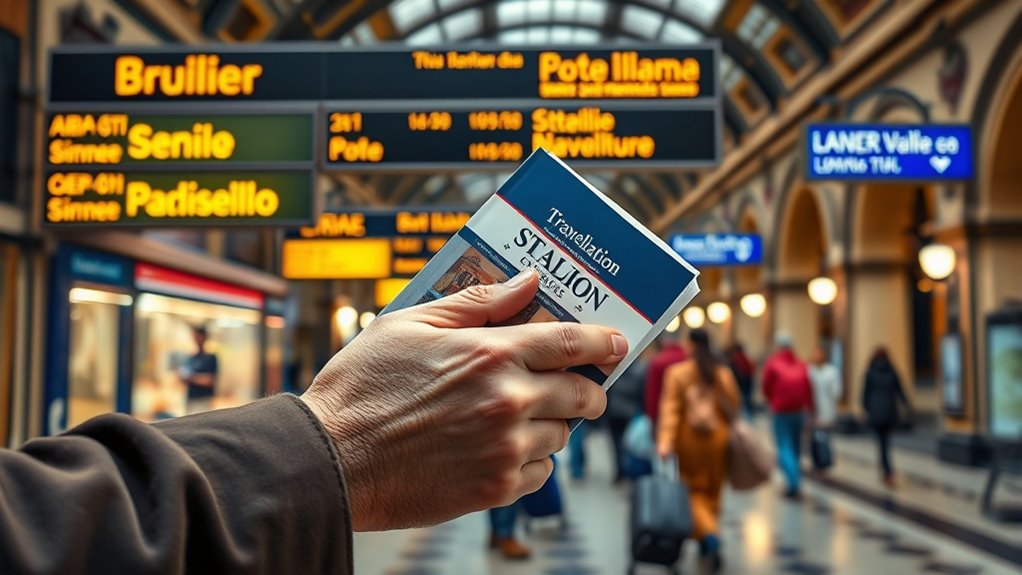To navigate Italian train stations smoothly, recognize common symbols like train icons, platform numbers, and service signs for restrooms, food, and assistance. Pay attention to electronic departure boards, track indicators, and signage pointing to ticket counters or help desks. Using color codes, arrows, and bilingual cues makes finding your way easier. If you keep exploring, you’ll discover practical tips to interpret these signs confidently and make your journey stress-free.
Key Takeaways
- Learn common symbols like train icons, ticket machines, restrooms, and info desks for quick navigation.
- Recognize platform and track indicators, including platform numbers and departure/arrival boards.
- Follow signage for ticketing areas labeled “Biglietteria” and assistance points marked “Informazioni” or “Help.”
- Identify amenities signs such as “Ristorazione” for food, “Servizi” for services, and accessible symbols.
- Use visual cues, color coding, and multilingual signs to navigate transfers, connecting trains, and station facilities efficiently.
Common Symbols and Icons Used in Italian Train Stations
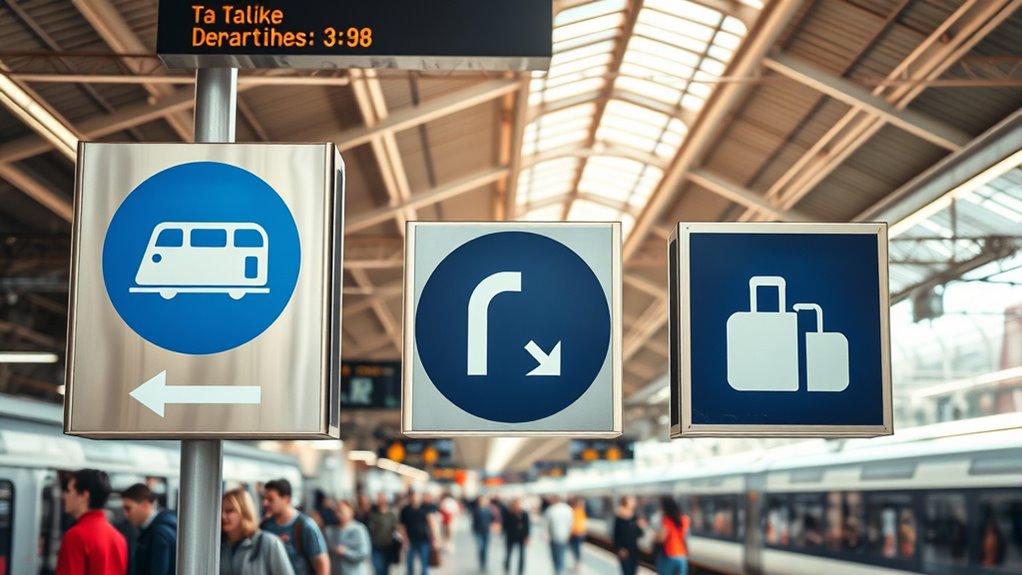
You’ll often notice familiar symbols throughout Italian train stations that make navigation easier. These symbols help you quickly understand station layout and processes like ticket validation. Look for icons indicating where to validate your ticket—usually a small machine with a ticket symbol or an arrow pointing to a validation point. Station layout symbols, such as maps or directional arrows, guide you to platforms, exits, and amenities. Pay attention to icons for restrooms, ticket offices, and information desks. Many symbols are universal, like a train for platforms or a luggage icon for baggage services. Recognizing these icons saves time and reduces confusion, especially if you’re unfamiliar with the station. Incorporating industry trends in icon design further enhances user-friendliness and accessibility. Additionally, understanding the essential symbols used in station signage ensures a smoother and more confident navigation experience. Embracing the standardized iconography common in transit systems can also help travelers adapt quickly regardless of the station or country. Furthermore, staying aware of future developments in station signage can prepare you for new or upgraded symbols and interfaces. Being familiar with these visual cues can also improve your overall travel efficiency and comfort.
Understanding Platform and Track Indicators

Have you ever wondered how to quickly find the right train when arriving at an Italian station? Understanding platform and track indicators makes this easier. Look for signs that specify platform numbers and track arrangements, often displayed on electronic boards and station maps. These indicators are essential for navigating the station layout and choosing your correct platform. For example:
| Platform | Track | Direction |
|---|---|---|
| 3 | 7 | Milan-bound |
| 2 | 4 | Florence-bound |
| 1 | 2 | Venice-bound |
Knowing which platform to go to saves time and helps you explore your ticketing options, such as ticket machines or counters, within the station. Clear track indicators ensure a smooth journey across Italy’s extensive train network. Additionally, train station navigation can be improved by familiarizing yourself with common signage and station layouts, making your experience more efficient. Remote work techniques can sometimes be applied to travel planning, helping you organize your trip more efficiently. Additionally, understanding zodiac sign compatibility can enhance your travel experiences by offering insights into cultural traditions and interpersonal interactions during your journey. Being aware of station signage conventions can further streamline your navigation process and reduce confusion.
Reading Signage for Ticketing and Ticket Offices

When you need to buy a ticket, look for clear signs pointing to ticket counters or machines. Pay attention to symbols and labels that identify where you can purchase or validate your tickets. Recognizing these signs makes your journey smoother and helps you avoid confusion. Additionally, understanding site navigation can help you quickly locate the ticketing area amidst other station facilities. Using wayfinding techniques can further assist in efficiently moving through the station environment. Being aware of station hours can also help you plan your visit to avoid arriving when the ticketing services are closed. Familiarity with station signage can improve your ability to interpret various instructions and directions throughout the station, especially when combined with knowledge about home decor elements like wall organization systems that can help you navigate indoor spaces more comfortably.
Ticket Counter Indicators
At Italian train stations, clear ticket counter indicators guide travelers directly to the ticket offices. These signs often display words like “Biglietteria” or “Ticket Office,” making it easy to find assistance with ticketing procedures. When approaching the counter, remember to validate your ticket if required—stations usually have dedicated validation machines nearby. Be prepared to ask questions about train schedules or fare options. Familiarity with the Vetted – Halloween Product Reviews can help ensure you’re prepared for any themed events or costume needs during your travels. Additionally, understanding the Bedroom layout and signage can assist travelers unfamiliar with station decor and navigation cues. Recognizing the production quantities indicated on signs can also help travelers gauge the volume of ticket sales or station activity in busy periods. Being aware of the ticketing schedules can further streamline your experience, especially during peak hours. Incorporating sound design principles, such as clear and distinct signage sounds or auditory cues, can improve station accessibility for visually impaired travelers.
Ticket Machines Labels
Look for clear labels on ticket machines, such as “Biglietti” or “Ticket Machine,” to quickly identify where to purchase your tickets. These labels help you locate the ticket machine functions, like selecting your destination, ticket type, or number of passengers. Pay attention to ticket machine symbols, such as a train icon or a ticket icon, which indicate the machine’s purpose. Many machines also display language options, making it easier if you’re not fluent in Italian. Once you find the right machine, follow the onscreen instructions, which are usually straightforward. Understanding these labels and symbols saves time and helps you navigate the ticketing process efficiently. Remember, clear signage guarantees you get your tickets smoothly before heading to the platform. Attention is a key factor in successful creative practice, ensuring you stay focused and make the most of your experience. Additionally, familiarizing yourself with cookie categories can enhance your browsing experience, especially if you need to access additional online resources while traveling. Being aware of ticket machine labels can also help you quickly identify the correct machine in busy stations. For example, some newer machines feature Vetted electric bike conversion kits, which showcase modern design and reliable operation, similar to well-designed ticket machines.
Locating Information Desks and Customer Assistance
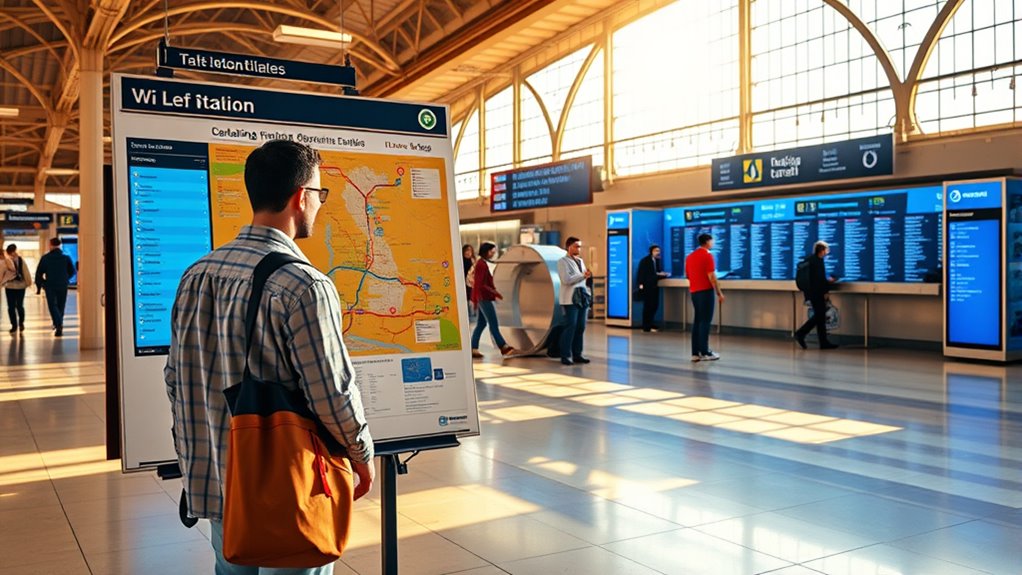
Most Italian train stations clearly mark their information desks with a prominent “Informazioni” sign, making them easy to find. When you need assistance with ticketing procedures or orienting yourself within the station layout, these desks are your go-to resource. Staff members at the desk can help clarify train schedules, platform assignments, and ticket options. Look for the “Informazioni” sign near main entrances or central areas, often close to ticket machines and platforms. If you’re unsure, follow signs for “Biglietti” or “Partenze”—they usually lead toward the info desk. Don’t hesitate to ask for help; station staff are accustomed to assisting travelers and can provide directions or answer questions promptly, ensuring your journey starts smoothly.
Deciphering Signage for Departures and Arrivals
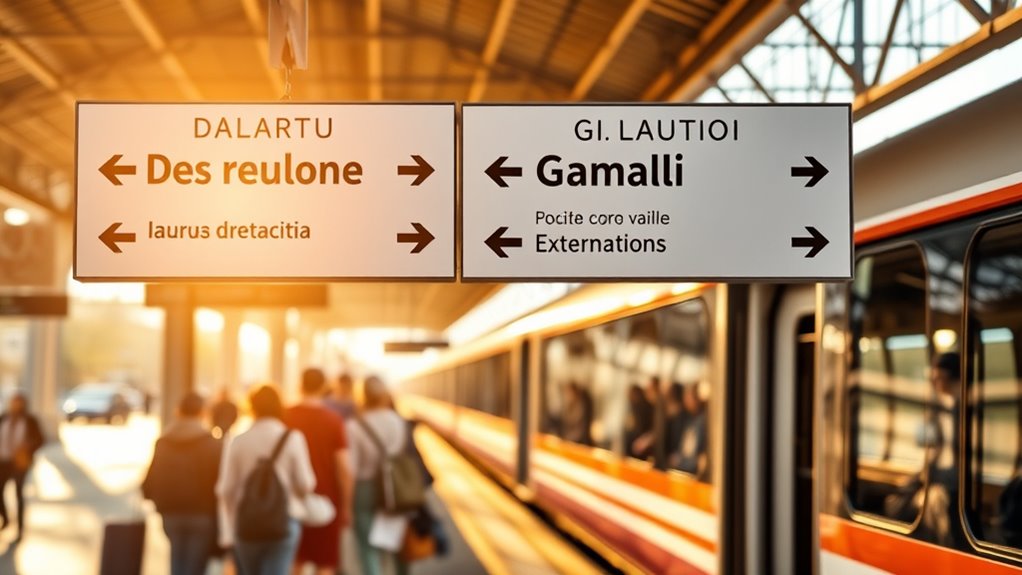
When you look at train station signs, you’ll see clear indicators for departures and arrivals. Recognizing the departure boards helps you find upcoming trains quickly, while understanding arrival signs shows you where to meet arriving passengers. Mastering these signs makes steering Italian stations much easier.
Recognizing Departure Indicators
Recognizing departure indicators on Italian train station signs is essential for steering your journey smoothly. These signs guide you to the correct platform and ensure you catch your train on time. Look for bold, often green or blue, signs displaying “Partenza” (Departure). Keep in mind:
- The train number and destination, so you know you’re heading the right way.
- The scheduled departure time, which updates frequently—stay alert for train schedule updates.
- Platform number, usually highlighted prominently, indicating where to wait.
- Important notices about ticket validation, reminding you to validate your ticket before boarding.
Understanding Arrival Signs
After identifying departure signs, it’s equally important to comprehend the arrival signs that indicate incoming trains. Arrival signs typically display train numbers, origin stations, and estimated arrival times. Look for symbols or color codes that connect to station layouts, helping you locate where your train will arrive. Keep in mind that ticket validation is necessary before boarding; arrival signs often remind travelers to validate their tickets if needed. Station layouts can vary, so familiarize yourself with maps to recognize platforms designated for incoming trains. Clear signage ensures you don’t miss your train, especially during busy hours. Paying attention to these signs helps you stay organized and confident at the station, making your journey smoother and more efficient.
Recognizing Signs for Restrooms, Waiting Areas, and Accessibility
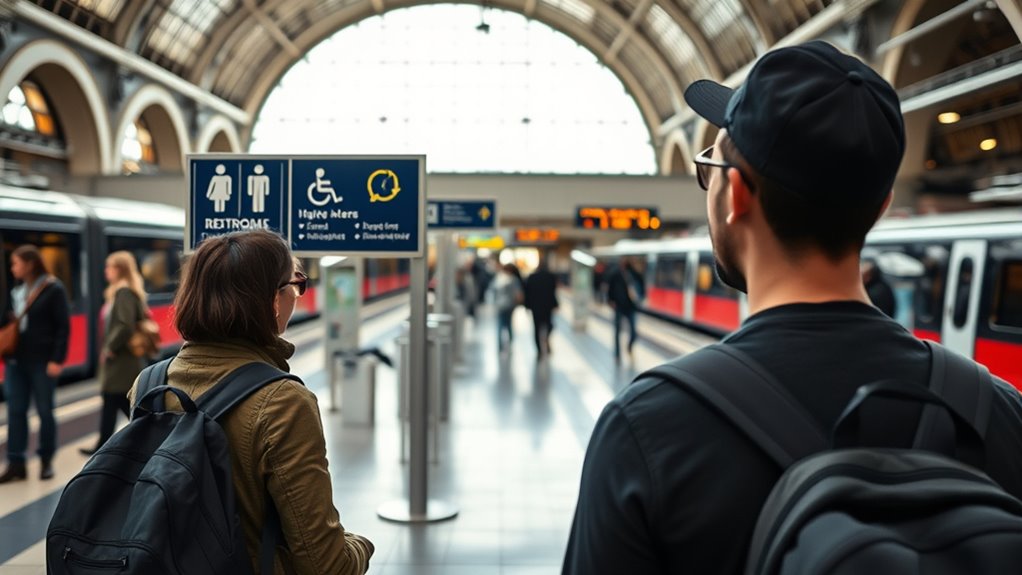
At Italian train stations, clear signs guide you to restrooms, waiting areas, and accessibility features. Recognizing these signs helps you feel confident and independent. Look for restroom symbols, which are universally recognizable icons indicating facilities for hygiene needs. Accessibility icons are designed to assist travelers with mobility challenges, ensuring everyone can navigate comfortably. Here are key signs to watch for:
- Restroom symbols—depicted with a person or toilet icon—pointing you toward facilities.
- Waiting area signs—often marked with a bench symbol—showing where you can relax.
- Accessibility icons—featuring a wheelchair symbol—highlighting accessible routes and facilities.
- Signage with clear, bilingual wording—making navigation easier for non-Italian speakers.
Pay attention to these signs, and you’ll move comfortably through the station.
Navigating Signage for Food, Shops, and Services

When you see signs for food, shops, and services at Italian train stations, they quickly guide you to the amenities that make your wait more comfortable. Look for symbols or words like “Ristorazione” for local cuisine or “Bar” for quick snacks. Signs for shopping districts often say “Spaccio” or “Shopping,” directing you to retail areas. You might also find “Servizi” indicating ATMs, information desks, or other essential services. These signs are usually bright and clear, often with icons that help you identify options easily. Following them will lead you to cafes where you can try regional dishes or shops where you can browse local products. Using these signs helps you enjoy the station’s amenities without confusion or delay.
Interpreting Signs for Connecting Trains and Transfers
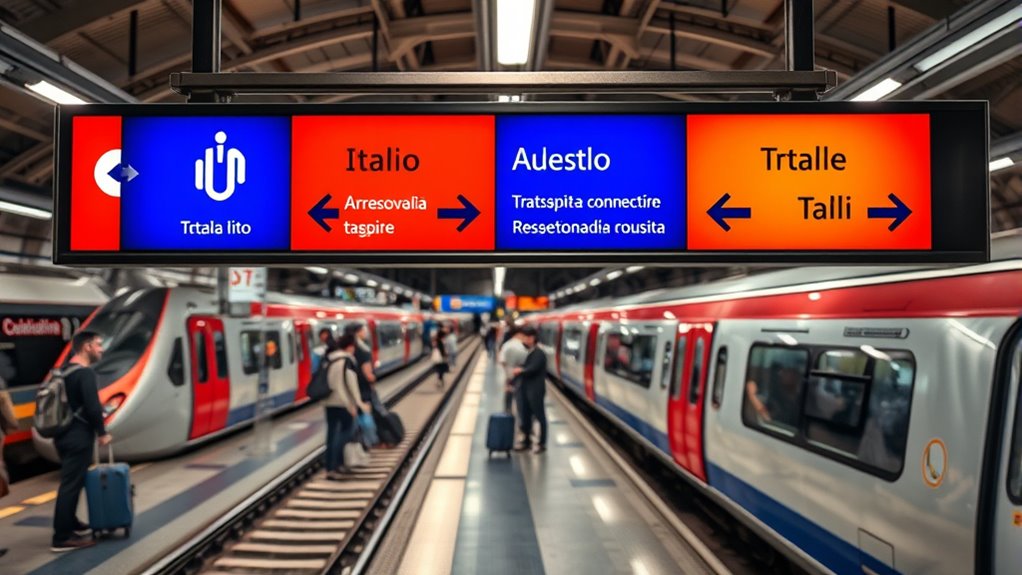
When you see signs for connecting trains, look for clear symbols and labels that guide you to transfer zones. These symbols often include arrows or icons indicating where to switch lines or platforms. Understanding these signs guarantees you reach your connecting train smoothly and on time.
Transfer Zones Explained
Ever wonder how to quickly identify where your connecting train is? Transfer zones are your best clues. They’re clearly marked areas that guide you to connecting platforms for your next train. Look for signs with bold text like “Transfer” or “Percorso Intermodale.” Here’s what to focus on:
- Transfer Zones Signage – Large, easy-to-spot signs indicating transfer areas.
- Connecting Platforms – Arrows pointing to the platforms where your connecting train departs.
- Color Coding – Some stations use colors for different lines or transfer zones.
- Floor Maps – Visual guides showing your current location and connecting routes.
Connecting Train Symbols
Connecting train symbols are your quick reference points for identifying the correct platform or route for your transfer, so paying attention to these signs can save you time and confusion. These symbols often indicate which train you need to catch next, helping you follow the train timetable efficiently. Keep an eye out for icons that show arrows, train types, or destination names; they guide you to the right platform quickly. Remember, maintaining platform safety is vital—stay behind safety lines and watch for ongoing trains. Connecting symbols also help you confirm that you’re on the correct route, avoiding unnecessary detours. By understanding these signs, you guarantee smooth transfers and a safer, more confident journey through Italian train stations.
Safety and Emergency Signs in Italian Stations

Safety and emergency signs in Italian train stations are designed to quickly communicate essential information and guide you during emergencies. Recognizing these signs can be vital for your safety, especially during urgent situations. Here are key points to remember:
Safety signs in Italian stations help you stay safe and respond confidently in emergencies.
- Follow platform safety signs to stay clear of moving trains and prevent accidents.
- Locate emergency exits immediately if you hear alarms or see flashing lights.
- Identify fire extinguisher symbols to respond effectively during fire emergencies.
- Learn evacuation routes marked by clear signage to ensure swift movement during emergency procedures.
Being aware of these signs helps you stay safe and act confidently in critical moments. In an emergency, understanding these signs can make all the difference in protecting yourself and others.
Tips for Using Multilingual Signs and Getting Help
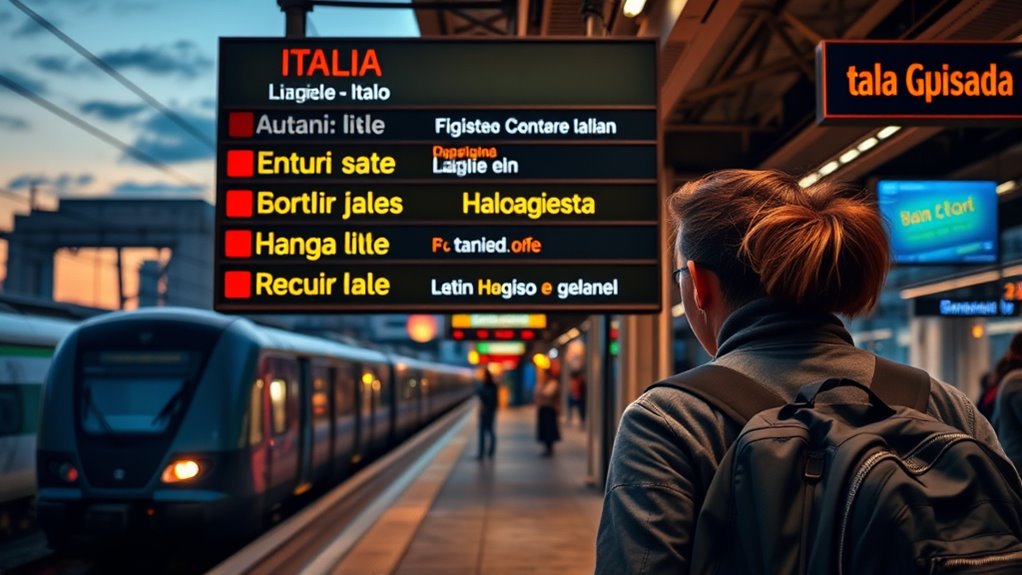
Even if you’re not fluent in Italian, using multilingual signage at train stations can help you find assistance quickly. Look for signs that display information in multiple languages—these are designed to guide travelers like you. Assistance language tips include noting common phrases such as “Help,” “Information,” or “Assistenza.” If you’re unsure, don’t hesitate to approach station staff; many speak some English or other major languages. Carrying a translation app or a phrasebook can also be handy when you need to clarify directions or ask for help. Keep an eye out for symbols or pictograms alongside multilingual signage, which can provide instant understanding. Using these tips, you’ll navigate the station more confidently and access assistance efficiently when needed.
Frequently Asked Questions
How Can I Identify Multilingual Signs Quickly in Busy Stations?
When you’re in a busy station, look for visual cue differences like distinct symbols or font styles that set multilingual signs apart. Color coding strategies can help too—many stations use specific colors for different languages or destinations, making it easier to identify the right sign quickly. Keep an eye out for these visual cues and color patterns, so you can navigate efficiently without getting overwhelmed by the crowds.
Are There Specific Symbols Indicating Station Security Measures?
You’ll notice symbols indicating station security measures, focusing on platform safety and baggage security. Look for icons like CCTV cameras, security personnel, or baggage check signs, often placed near entrances, platforms, or baggage claim areas. These symbols quickly inform you about safety protocols, helping you stay vigilant. Recognizing them guarantees you understand the station’s security measures, making your travel experience safer and more relaxed.
How Do I Recognize Signs for Special Assistance or Disability Services?
Imagine finding the help you need with just a glance—it’s possible when you spot signs for special assistance. Look for symbols like the wheelchair icon or Braille signage, which indicate accessibility features. Additionally, listen for audio announcements that provide guidance. These cues work together, ensuring you navigate the station comfortably and confidently, turning a potentially confusing experience into a smooth journey.
What Symbols Indicate Station Amenities Like Wi-Fi or Charging Stations?
You’ll notice symbols for amenities like Wi-Fi or charging stations on the train station layout, often near entrances or main areas. Look for icons resembling a Wi-Fi signal or a power plug. These signs help you quickly locate these services, alongside ticket counter locations and other facilities. Familiarizing yourself with common symbols guarantees you can navigate efficiently, find the amenities you require, and better understand the station’s layout during your travels.
How Can I Distinguish Emergency Exit Signs From Regular Signage?
You might find the station’s safety cues subtly guiding you. Emergency exit signs often feature clear, universal symbols like a running figure or an arrow pointing to an exit, usually in bright green or illuminated. Unlike train schedule icons or ticket purchasing signs, these signs are designed to catch your eye quickly, ensuring safety. Keep an eye out for distinctive shapes and colors that stand out from the usual signage, signaling a safe route in case of need.
Conclusion
Mastering Italian train station signs makes your journey smoother, even if you’re not fluent in Italian. Don’t worry if some signs seem confusing—most stations use universal symbols to guide you. With a little practice, you’ll navigate platforms, ticket offices, and services confidently. Remember, staff are usually happy to help if you’re unsure. So trust your instincts, stay attentive, and enjoy your trip through Italy’s beautiful rail network with ease!
